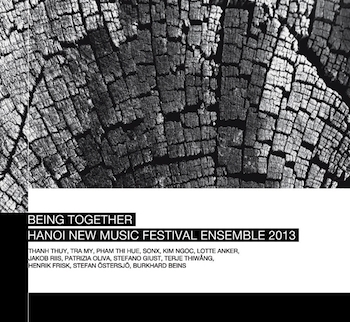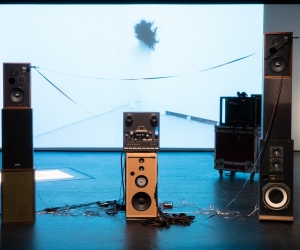
Although Hanoi is more closely associated in North American minds with 1960s Vietnam War designators like the Ho Chi Minh trail and the Hanoi Hilton, the city now has an improvised music scene, and this disc celebrates Hanoi’s first-ever New Music Festival. Being Together, a three-part piece based on a graphic score by Danish saxophonist Lotte Anker, was the finale of the ten-day fest, which saw participation from five locals playing traditional instruments as well as eight attendees from Sweden, Denmark, Italy, and Germany.
Many attempts at creating cross-cultural music fall into the category of so-called World Music, which slams together divergent sounds with a brutality like that of trying to erect a Trump Tower next to the Trấn Quốc Pagoda, Hanoi’s oldest Buddhist temple. Dissonance works in Being Together’s favour, however. Plucked textures from the đàn đáy (three-string Vietnamese lute) or đàn bầu (one-string indigenous zither), sit comfortably alongside manipulated drones from the electronics of Jakob Riis, Patrizia Oliva, and Henrik Frisk.
Resolution arrives in “Part 3,” a performance approaching free-jazz abandon, as tones from Anker’s soprano saxophone and Terje Thiwån’s flute showcase slurred double counterpoint, underscored by crackling slaps from percussionists Burkhard Beins and Stefano Giust, while the string players radically twang and plink. Distinctive bifurcation is still present: on earlier tracks, Oliva’s European bel canto-like warbles and Kim Ngoc’s Asian throat-wiggling are electro-distorted or paired with nearly identical horn expositions. As extraneous tones ranging from miniature finger-cymbal jangles and harmonium-like electronic fills retreat, the vibrating romanticisms and exotic chipmunk-like vocal chattering of both become evident. Reaching a climax of whistling, spluttering, and buzzing, the acoustic, vocal, and electronic timbres meld, confirming the state of things that the CD’s title puts forth. Being Together is a notable historical, as well as musical, achievement. In future, what would be equally fascinating is to find out what Vietnamese improvisers are doing in terms of creating their own electroacoustic sounds.


